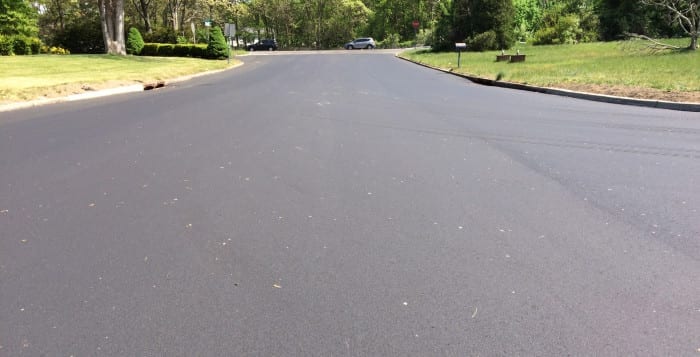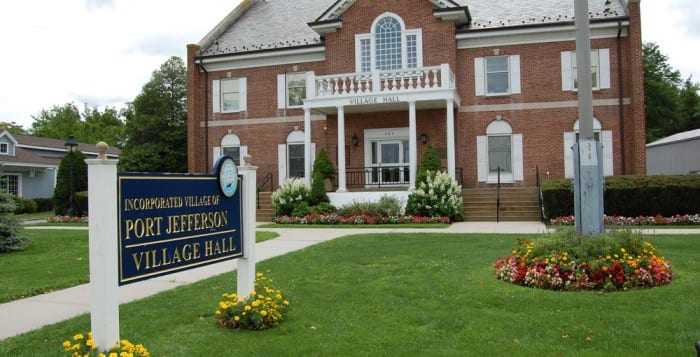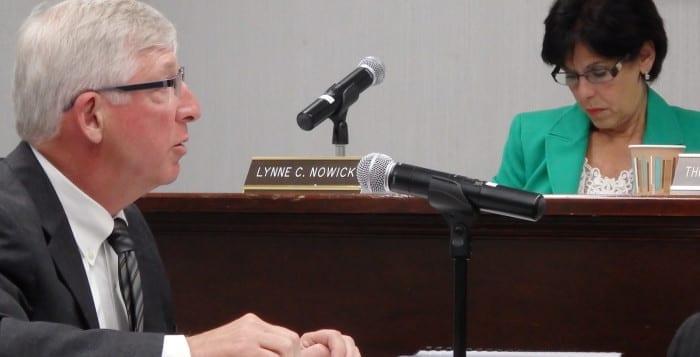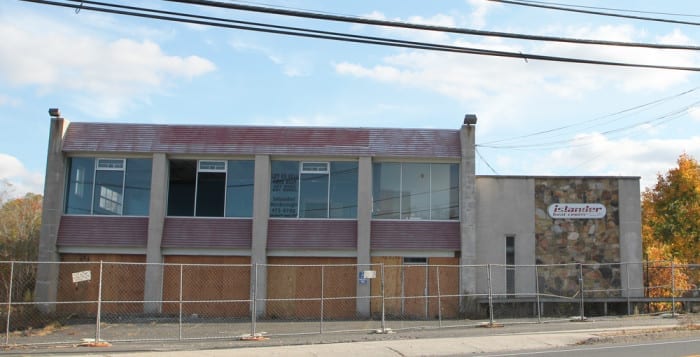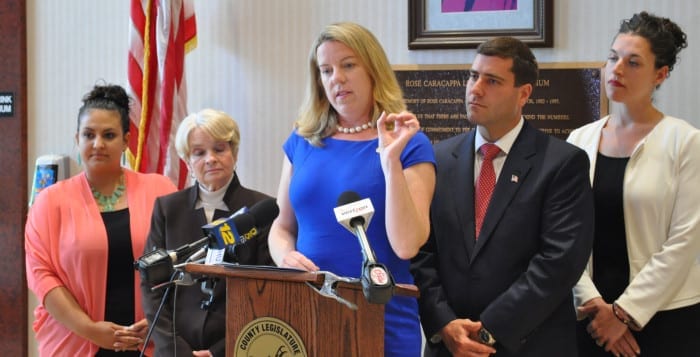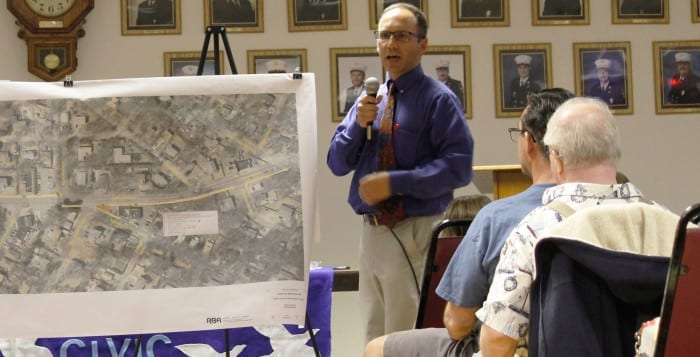Port Jefferson government will have at least one new face this summer.
Three seats on the village board of trustees are up for election in mid-June, including those of the mayor and two trustees. Mayor Margot Garant is running for a fourth term and faces a challenge from resident Dave Forgione. Trustee Larry LaPointe is on the hunt for his third term on the board, running against resident Matthew Franco and Stan Loucks, chairman of the County Club Management Advisory Council.
Trustee Adrienne Kessel, whose third term is ending this year, is not running for re-election. In a phone interview, she called being on the board “a tremendous commitment.”
“I just felt that after 6 years, I’m hoping that some good candidates step up,” she said. It’s “time to kind of reclaim a little more time for myself.”
She said she would continue to serve on the village’s architectural review committee and as the head of the committee involved in upgrading Rocketship Park in downtown Port Jefferson. Kessel has been a driving force in fundraising and design for the park project.
Kessel advised whoever succeeds her to take the job seriously and make decisions based on what is best for the village as a whole.
“Many, many things come into view when you become a trustee,” she said. “You begin to see an entirely new picture of the village where you live.”
Voting is on Tuesday, June 16, at the Village Center, from 6 a.m. to 9 p.m.
Mayor
Garant said she is not ready “to turn over the keys.”
She said she is still working toward getting the aging local power plant upgraded — or repowered — so it continues operating and thus remains a source of property tax revenue for the village. The incumbent is also focused on completing Port Jefferson’s comprehensive plan, which outlines recommendations for development throughout the village, and on pushing for revitalization in the uptown area, which has issues with vacant buildings and crime.
“The first several years of my administration I felt that I was doing a lot of corrective work,” Garant said, between fixing infrastructure that had been long neglected and stabilizing the budget. “We’re finally moving, I feel, in a very, very positive direction.”
She is also advocating to get a Town of Brookhaven jetty in Mount Sinai repaired, as the jetty, which is between Port Jefferson’s East Beach and Mount Sinai Harbor, in its damaged state allows currents to carry sand away from the village beach, causing erosion.
“We have a really good rhythm and I’d really hate to see that interrupted or, worse, for us to take a step backward,” the mayor said. With another two years, “I will work as hard as I have for the last six.”
Her challenger, Forgione, who has lived in the village for 15 years and operates a billing and accounting business in upper Port, said he threw his hat in the ring because “our village deserves a choice.”
He wants to more tightly control village taxes and help financially prepare the village in the event that the community loses property tax revenue from the Port Jefferson power plant. Forgione would also like to call on the state and the Long Island Rail Road to upgrade the crossing in upper Port to relieve traffic congestion, and work with the Suffolk County Police Department and village code enforcement officers to reduce crime in that area.
Another issue for the challenger is transparency — he said he would like to upgrade the village website to collect more public opinions on government proposals.
Forgione, a veteran of the U.S. Army Reserves and the National Guard, said his current and past experience in business and finance, on the local board of assessment review, on the Comprehensive Plan Advisory Committee, on the school district’s budget advisory committee, and as a fiscal manager for a cancer screening program with the county health department would help him lead the village.
“I want to maintain that small-town feel with the residents and the business owners while encouraging growth in the 21st century.”
Trustees
LaPointe said he is running for re-election because there is “unfinished business” in the form of projects he wants to see through.
The incumbent, a retired attorney, has been working on renovations in the village’s downtown parking lots and on improving security by strengthening a network of cameras in commercial areas, among other projects.
“So we have a lot on our plates,” he said.
The trustee said he is proud of his work to increase police presence in lower Port — improving safety particularly on weekend nights during the village’s peak summer season — and of his role in renovating the country club golf course and maintenance building.
He also said the village now has a club “that’s second to none.”
“After a lot of hard work, the village is finally starting to get into a good place — a place where we’re economically secure, a place where we can look forward to a bright future,” LaPointe said when asked why residents should vote for him.
One of his challengers, Loucks, has lived in the village since 1981 and is a retired athletics teacher and administrator in Plainview-Old Bethpage. He is running for the village board because after volunteering on the CCMAC for a number of years, “I feel I have so much more to offer to the village than just working with the membership up at the country club.”
Loucks said he wants to work toward repowering the Port Jefferson power plant, revitalizing upper Port and broadening the village’s tax base.
“I also want to get involved … in making a better relationship between the schools and the administration downtown.”
He said the village and the school district should work more closely, partnering more on things like recreation programs.
Loucks said one of his strong points is budgeting, after working as a school administrator. At Plainview-Old Bethpage, “I was handling budgets larger than the village budget. … And I was always able to make ends meet.”
He said people should vote for him because he is good at listening and organizing.
“Along with the budgeting I think my strong point is my ability to get along with everyone.”
The third candidate for a trustee seat, Franco, has lived in the village for 10 years and is a pediatric occupational therapist for Nassau BOCES. He is running for a trustee position because he thinks taxes are too high and there is “very little transparency” in the village government.
“The biggest thing that we need to do … is inform the community of what’s going on,” he said in a phone interview. “There is no openness to this government. … They should be entitled to all the information that’s going on in the village.”
Franco also has concerns about the village’s efforts to revitalize upper Port — he said the level of development that the village’s proposed comprehensive plan would allow there would congest Main Street.
“They’re not really addressing the traffic issue and that is an ambulance route,” he said.
According to Franco, the village could use incentives like tax credits to get local business owners uptown to redo their facades, or other similar methods of enhancing upper Port.
“Our small businesses are an invaluable component to our village and I don’t think they’re being dealt with in an effective manner.”


